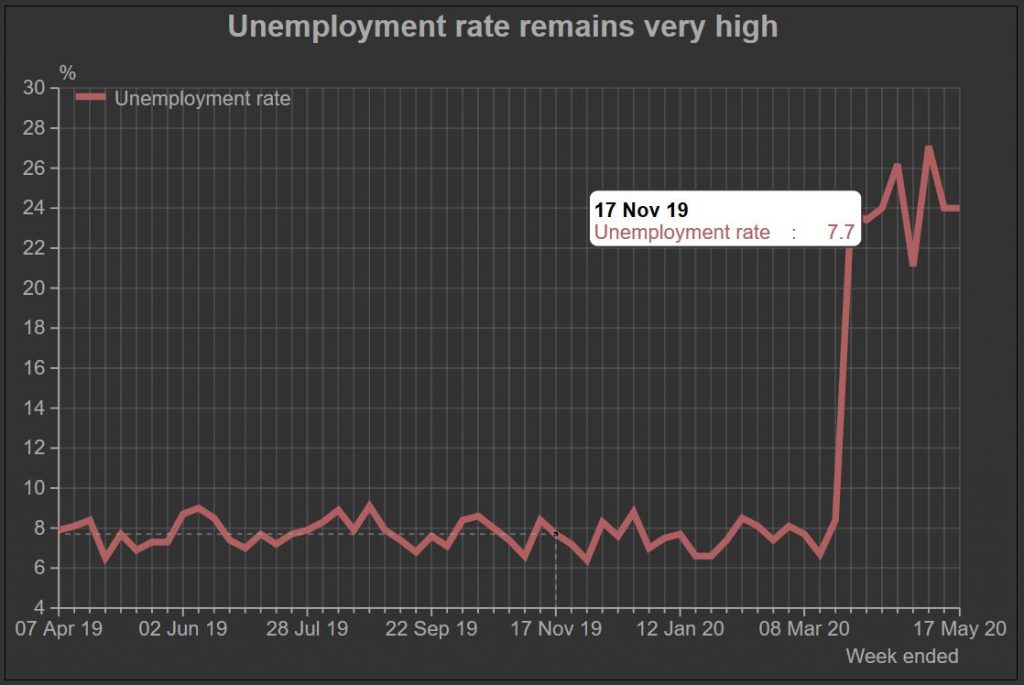
The unemployment rate remained stable at 24 percent during the week ended May 17. This is the same as it was in the preceding month. Halfway into the month of May, it appears that the unemployment rate is around the same level as it was in April. It remains mostly higher by a whisker. The small relaxations in the lockdown since April 20 have not had any positive impact on the unemployment rate, yet.
However, the relaxation seems to have had an impact on the labour participation rate. This has bounced back from its lowest level of 35.4 percent in the week ended April 26. In the next week ended May 3, it scaled back to 36.2 percent. And, then, shot up smartly to 37.6 percent in the week ended May 10 and now, in the latest week of May 17 it increased to an even better 38.8 percent.
Evidently, people are coming back to the labour markets as the lockdown eases. Demand for labour is likely to have gone up as transport facilities are being organised to allow migrants to go back to their homes and as zoning efforts lead to some limited and localised economic activities.
But, the much belated return of a much harrowed migrant labour to their homes is likely to complicate, significantly, the re-starting of the economy post the ever elusive lifting of the lockdown. Uncertainty continues to prevail. The lockdown was extended. Initially, some states extended the lockdown to the end of May and then finally, the Centre announced a national lockdown till the end of May 2020.
Uncertainty of when the lockdown would be lifted, the nature of economic activity post lockdown, fears of the disease, fears of lack of medical facilities, fears of sudden loss of livelihood and the traumatic experience during the lockdown is likely to keep labour away, within the safety of their homes in their villages or small towns. Enterprises of essential services that were working during the lockdown with the help of ’trapped’ labour have already felt the impact of this labour fleeing the moment transport was available to go home.
Restarting the economy after lifting the lockdown would therefore be a big challenge. India faces a particularly complex phenomenon because of its handling of migrant labour during the lockdown.
A persistently high unemployment rate indicates that a large proportion of labour that is willing to work is unable to find jobs. And, the sharp fall in labour participation rate indicates that lesser people are willing to work.
The single biggest proposition in the economic package announced by the government so far is that it proposes to give easy credit including to MSMEs and to street hawkers. This is unlikely to make a big positive impact. But, its allocation for rural employment could make a small impact.
The government proposal that is likely to have a good impact on rural labour is the additional allocation of Rs.400 billion to the Mahatma Gandhi National Rural Employment Guarantee Scheme for the current year. This is in addition to the Rs.615 billion that was announced in the budget for the year. With this, the scheme is expected to generate 3 billion person days of jobs in 2020-21. 2.65 billion person days of jobs were created from the Rs.710 billion allocated to the scheme in 2019-20.
Wage rate under the scheme was also raised earlier. Migrant labour that returns to their homes in rural India has a hope from this increased allocation to the MGNREG scheme and the higher wage rates.
Rural India employed about 276 million in 2019-20. But, post the lockdown this fell to 197 million in April 2020. Presumably, the additional allocations to MGNREGS would raise this 197 million by at most 10 percent. Part of the 13 percent increase in the allocation would go into the wage rate increase. Therefore, the additional allocation to the scheme may raise employment in rural India to around 216 million. This may provide some succour to rural India and hopefully to the harrowed migrants and their families. But, of course, it leaves a lot to be done.
And, it leaves urban India with an unattended problem. Urban India has a higher unemployment rate of 27 percent compared to rural India’s 23 percent. And, it has a lower labour participation rate of 34 percent compared to 41 percent in rural India. Less than 25 percent of urban working age population is employed. Urban India has the better educated and better skilled labour.
The government’s apparent resistance to spurring demand through direct unilateral transfers to households and the extension of the lockdown implies that the economy would take a long time to recover. The future for labour is of more tapasya and more tyaag.










